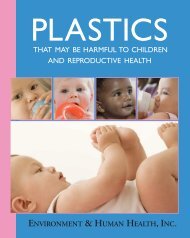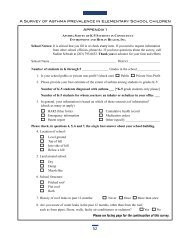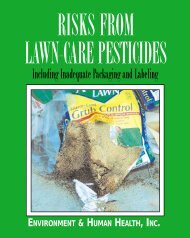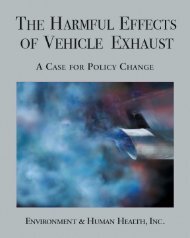LEED Report - Environment & Human Health, Inc.
LEED Report - Environment & Human Health, Inc.
LEED Report - Environment & Human Health, Inc.
- No tags were found...
You also want an ePaper? Increase the reach of your titles
YUMPU automatically turns print PDFs into web optimized ePapers that Google loves.
The Green Building DebateIndoor Air QualityL E E D O f f e r s L i t t l e A s s u r a n c eo f H e a l t h P r o t e c t i o nNew construction or renovation projects are eligible to receive amaximum of 110 total point credits. Only 15 credits are available formeeting <strong>LEED</strong> standards for indoor environmental quality, and seven ofthese credits are associated with thermal comfort and lighting. Sincenone of the eight remaining air quality credits are required, a buildingcould earn no credits for air quality assurance and still be awarded thehighest level of certification—“platinum.”The vast majority of chemicals in indoor environments remainunregulated under federal, state and local law. Moreover, if history isany guide, the situa tion will not improve soon. Without a comprehensivenew approach, these already serious threats to health from airpollution will persist.EPA’s air quality regulations do not assure air quality for many reasons.The agency has spent most of its resources attempting to regulate onlysix “criteria pollutants” that are common in outdoor air. ‘To a lesserextent, some attention is given to 189 others known as “hazardous airpollutants.”Heating and coolingsystems that recycle airrather than exchangingindoor and outdoor air, aswell as windows that donot open, especially in restrooms, often lead to anaccumulation of chemicaland biological agents thatcan trigger or exacerbateasthma and lead to otherrespiratory problems.Thousands of additional chemicals are routinely released both outsideand inside. It takes about 10 years after EPA becomes aware of a dangerfor it to revise a standard for a single air pollutant—such as ozone orfine particles—and even when tougher stan dards are set, manufacturersare granted a four-year period before the new rules apply.Many factors can contribute to poor indoor air quality, includingoutdoor air pollution that flows into buildings. In addition, indoorair can contain pollutants from cleaning products, pesticides,formaldehyde in furniture and insulation, paints and other wood17







